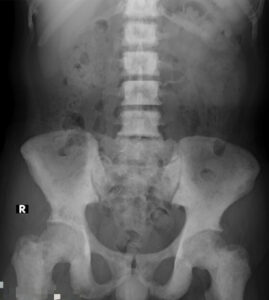Mesothelioma Stages
There are four mesothelioma stages. Stage 1 is the least advanced and easiest to treat while stage 4 is the most advanced. Though early-stage mesothelioma patients often live longer, treatment can help at every stage. Find medical care for your mesothelioma stage right now with our help.
What Are the Stages of Mesothelioma?
Stage is a way that doctors measure how far a cancer has spread in your body. Cancer staging greatly affects a patient’s overall prognosis (health outlook) and what treatments they can receive.
There are four malignant mesothelioma stages in most cases. In stage 1, the cancer is still relatively contained to where it first formed. Early-stage mesothelioma patients can often receive treatments to help them live longer. Stage 4 mesothelioma has spread throughout the body and treatment often focuses on easing pain.
 Most mesothelioma cases aren’t diagnosed until stage 3 or 4, as the symptoms of this cancer are often very mild at first. Thus, many patients delay a doctor for a diagnosis and the cancer has more time to spread.
Most mesothelioma cases aren’t diagnosed until stage 3 or 4, as the symptoms of this cancer are often very mild at first. Thus, many patients delay a doctor for a diagnosis and the cancer has more time to spread.
However, mesothelioma patients need to know that medical care can help, no matter what stage they’re diagnosed with.
Seek the help of oncologists (cancer doctors) if you might have mesothelioma. These specialized doctors can determine what mesothelioma stage you have and recommend a treatment plan.
Mesothelioma and lung cancer can both be caused by asbestos exposure, and the Lung Cancer Group team knows how devastating cancer is. We can help you find and afford top treatments for all mesothelioma stages. Get a free case review to find out your eligibility.
- Access Financial Aid and Justice
- Learn About Your Options
- Contact Us for Free

Pleural Mesothelioma Stages
There are several types of mesothelioma depending on where the cancer tumors form, and the type impacts how your cancer is staged.
Malignant pleural mesothelioma forms in the pleura (the lining of the lungs) and accounts for more than 75% of all cases, according to the American Cancer Society (ACS).
Pleural mesothelioma is the only type of this cancer to be classified into stages. There are four pleural mesothelioma stages. Learn about each stage below.

In cases of stage 1 pleural mesothelioma, the tumors are found within the pleura on one side of the chest wall. The cancer may have also started to spread to other nearby body parts. Patients often don’t have any mesothelioma symptoms at this stage.
Doctors can classify cases of mesothelioma stage 1 into two substages depending on the spread.
These substages include:
- Stage 1A: Mesothelioma tumors have grown into the diaphragm (a muscle at the bottom of the chest that helps with breathing) or a lung.
- Stage 1B: The mesothelioma tumors are found in the mediastinum (space between lungs), layers of the chest wall, or the top of the pericardium (heart lining).
All stages of pleural mesothelioma are dangerous, but stage 1 is the easiest to treat. Doctors can often effectively treat mesothelioma stage 1 by removing the cancer tumors using surgery.

Stage 2 pleural mesothelioma is very similar to stage 1 mesothelioma, with the main difference being that the cancer has reached nearby lymph nodes.
Lymph nodes are tiny organs that look like beans, and they help filter out toxins from your body through the lymph system. Unfortunately, cancer cells can sometimes ride through the lymph nodes and reach other body parts, allowing new tumors to grow in other areas. This spread is called metastasis.
Thankfully, cases of mesothelioma stage 2 can still be treated relatively easily through surgery and other options. Doctors will likely want to remove nearby lymph nodes that have become cancerous, as well as all visible signs of the cancer, when treating stage 2 mesothelioma.

In the third stage of pleural mesothelioma, the cancer has had time to spread to other parts of the body outside of the chest — including to major organs.
Mesothelioma patients are often diagnosed in this stage as by this point common symptoms like difficulty breathing and chest pain have appeared. A recent study of roughly 300 pleural mesothelioma patients found that over 62% of them were diagnosed in stage 3.
Like in stage 1, mesothelioma stage 3 is classified into two substages.
These substages include:
- Stage 3A: Cancer tumors have grown into the mediastinum, chest wall, pericardium, and nearby lymph nodes on one or both sides of the body. Surgery might still be an option for these patients.
- Stage 3B: Mesothelioma tumors have reached the esophagus, heart, abdominal lining, spine, or the other side of the chest wall. Doctors cannot safely perform surgery at this stage.
As noted above, stage 3 mesothelioma marks the point where treatments start to get limited due to the spread of the cancer. Doctors will determine which treatments will work best if you have mesothelioma stage 3 and do everything they can to help you live longer.

Stage 4 pleural mesothelioma is the most advanced stage and the hardest to treat. Here, mesothelioma tumors reached distant parts of the body.
Past studies have shown that stage 4 mesothelioma can spread to the:
- Adrenal glands
- Bones
- Kidney
- Liver
- Spinal column
Mesothelioma stage 4 cannot be treated with aggressive surgery, but doctors can still help patients by using other treatments like chemotherapy, radiation, and palliative (pain-relieving) care.
Peritoneal Mesothelioma Stages
Peritoneal mesothelioma forms in the lining of the abdominal cavity (peritoneum). It accounts for about 10-15% of all mesothelioma cases.
 Doctors don’t classify peritoneal mesothelioma into official stages at this time as it rarely spreads beyond the abdomen. That said, peritoneal mesothelioma is still life-threatening and extremely dangerous.
Doctors don’t classify peritoneal mesothelioma into official stages at this time as it rarely spreads beyond the abdomen. That said, peritoneal mesothelioma is still life-threatening and extremely dangerous.
Doctors can determine how far the cancer has spread and informally diagnose patients as having “localized” or “advanced” mesothelioma.
In cases of localized peritoneal mesothelioma, the cancer is just found within the abdomen lining or nearby tissues. Late-stage or advanced peritoneal mesothelioma has spread to organs like the liver and spleen, as well as to the uterus or ovaries in women.
Pericardial & Testicular Mesothelioma Stages
There are also a few rare types of mesothelioma, these being pericardial and testicular mesothelioma. Neither has a formal staging system. Doctors can informally assign mesothelioma stages depending on how far the tumors have spread, though.
- Pericardial mesothelioma forms in the pericardium, or heart lining. This type of mesothelioma can reach the kidneys, liver, or lungs in advanced stages, according to the medical journal BJR Case Reports.
- Testicular mesothelioma forms in the lining of the testicles. Testicular mesothelioma can reach distant organs like the lungs and lymph nodes near the peritoneum and mediastinum, as noted by the journal Annals of Medicine and Surgery.
If you might have any type or stage of mesothelioma, see a doctor immediately. Doctors can see if you have cancer and recommend treatments depending on your mesothelioma stage, type, and other factors.
Lung Cancer Group can help you find and afford medical care for all mesothelioma stages. Call (877) 446-5767 now to learn more.
Mesothelioma Staging Systems
Doctors determine mesothelioma stage using a series of guidelines called a staging system.
The most commonly used mesothelioma staging system is the Tumor-Node-Metastasis (TNM) staging system. There are also several other staging systems that are rarely or never used at this time.
TNM Staging System
The International Mesothelioma Interest Group created the TNM staging system, and it’s the one currently used by leading cancer publications like the American Joint Committee on Cancer (AJCC) and the ACS.
The TNM has three components to assign stages:
- Tumor size (T): How big are the mesothelioma tumors? Have they spread into nearby body parts?
- Node (N): Has the cancer spread to nearby lymph nodes?
- Metastasis (M): Has the cancer metastasized to distant organs? If so, it’s automatically considered to be stage 4, according to the ACS.
The TNM system assigns numerical values to each of the three factors to determine the stage. Higher numbers add up to a later stage of mesothelioma.
Brigham Staging System
The Brigham staging system was created by leading pleural mesothelioma specialists, including Dr. David Sugarbaker. This system had four stages of mesothelioma like the TNM system. Each stage noted how far the cancer had spread and if the patient could receive surgery as a treatment or not.
However, this staging system wasn’t used by the mainstream medical community as it was too different from the TNM system. It was also too focused on surgery (which is not always an option for patients with late-stage pleural mesothelioma).
Butchart Staging System
The Butchart staging system was the first one used to stage pleural mesothelioma, created in 1976. This staging system was relatively simple, assigning one of four stages based on how far the cancer had spread within the body.
The Butchart staging system is not used to stage pleural mesothelioma today as the TNM system is more comprehensive and accurate.
SEER Staging System
The Surveillance, Epidemiology, and End Results (SEER) Program of the National Cancer Institute (NCI) has two general cancer staging systems. SEER was able to develop these systems as the program collects data about cancer patients all across the country.
The SEER staging systems are:
- Extent of disease (EOD) coding: Through this system, doctors give a 10-digit code to a cancer patient based on factors such as tumor size and what lymph nodes (if any) are involved.
- Summary staging: This basic staging system assigns one of five stages to a cancer tumor. It’s also known as SEER staging or general staging and can be used in many different parts of the body.
SEER staging systems are occasionally used to stage cases of mesothelioma but the TNM staging system is much more preferred.
Other Staging Systems
Besides the TNM staging system and the other rarely used ones, there are many other systems being studied — or possibly used — to stage mesothelioma. For example, researchers proposed a version of the TNM staging system for peritoneal mesothelioma in 2011 but it was not widely accepted.
Further, some doctors may occasionally use the Peritoneal Cancer Index (PCI) to stage peritoneal mesothelioma, according to the Cleveland Clinic. Using the PCI, doctors divide the abdomen into 13 sections and count how many sections contain cancer. A higher score means a later stage.
Existing staging systems continue to be improved as well. The TNM system for pleural mesothelioma is periodically reviewed and updated by the International Association for the Study of Lung Cancer (IASLC). This association often recommends tweaks to the TNM system during these reviews based on new research findings.
Diagnosing Mesothelioma Stages
Making a mesothelioma diagnosis and accurately determining your cancer stage go hand in hand.
If mesothelioma is suspected, doctors first will take note of your symptoms (and if you were ever exposed to asbestos, the only known cause of this cancer). Then they can order tests to help confirm the diagnosis.
Tests used to diagnose mesothelioma stages include:
- Imaging tests: X-rays, PET scans, and CT scans can all help doctors see within your body. These tests are very important when it comes to staging mesothelioma, as they can help show doctors how far the cancer has spread.
- Blood tests: Tests of your blood may allow doctors to detect mesothelioma biomarkers — substances like proteins that the cancer cells give off.
- Biopsies: A biopsy allows doctors to extract a tiny sample of fluid or tissue from an area that might be cancerous. Your doctors can then send this biopsy sample to a pathologist, who will look at it under a microscope and determine what cancer cells (if any) are present. This is the only way to be officially diagnosed with mesothelioma.
Once your cancer has been properly diagnosed, your doctors can then recommend a treatment plan based on your mesothelioma stage, overall health, and other factors.
How Mesothelioma Stage Affects Prognosis and Treatments
What stage of mesothelioma you have can greatly impact what cancer treatments are used and your overall prognosis.
Mesothelioma is much easier to treat in its earlier stages as the cancer can often be fully removed with surgery, which is the most effective treatment for almost all types.
Cases of late-stage mesothelioma are harder to treat and average life expectancies are low, but it’s still possible to become a long-term survivor. Many patients with late-stage mesothelioma are treated with chemotherapy, immunotherapy, or radiation rather than surgery.
View treatments for mesothelioma by stage and learn how they can help you live longer.
![]() Stage 1 Mesothelioma Treatments & Health Outlook
Stage 1 Mesothelioma Treatments & Health Outlook
Patients with stage 1 mesothelioma have the most treatment options of all. Arguably the most effective treatments for mesothelioma stage 1 are surgeries.
There are two major surgeries for stage 1 pleural mesothelioma:
- Extrapleural pneumonectomy (EPP): Through this surgery, doctors remove all of the cancer tumors that they can see from the lung and chest cavities, along with the pleura and the lung closest to the cancer.
- Pleurectomy with decortication (P/D): This surgery was developed as an alternative to the EPP. Doctors remove the cancer tumors and the pleura but a lung isn’t removed, allowing patients to recover faster.
Stage 1 pleural mesothelioma patients that received surgeries live for 21 months on average, according to the medical journal Frontiers in Oncology.
Other aggressive treatment options like chemotherapy and radiation therapy are used to amplify the effects of surgery in stage 1 mesothelioma patients. Either of these treatments may be used before or after surgery to shrink tumors or kill microscopic cancer cells that were left behind.
Patients with localized peritoneal, pericardial, or testicular mesothelioma may qualify for life-extending surgeries, too. A notable treatment for early-stage peritoneal mesothelioma combines cytoreductive surgery with heated chemotherapy (HIPEC). Cytoreduction with HIPEC helps peritoneal mesothelioma patients live for 53 months on average.
![]() Stage 2 Mesothelioma Treatments & Health Outlook
Stage 2 Mesothelioma Treatments & Health Outlook
Stage 2 mesothelioma patients have most of the same treatment options available as those in stage 1. Stage 2 pleural mesothelioma patients can often receive either an EPP or a P/D, along with other treatments like radiation, chemotherapy, and immunotherapy.
That said, patients with stage 2 pleural mesothelioma have a slightly shorter life expectancy and lower overall survival rate. Frontiers in Oncology found that stage 2 pleural mesothelioma patients treated with surgery live for 19 months on average — three months less than those with stage 1.
There’s not an official second stage for the other types of mesothelioma but surgeries and other treatments may be available if the cancer hasn’t spread far.
![]() Stage 3 Mesothelioma Treatments & Health Outlook
Stage 3 Mesothelioma Treatments & Health Outlook
Mesothelioma stage 3 can start to reach other parts of the body, which may limit a patient’s treatment options.
For example, an EPP or P/D may not be used on patients with stage 3B pleural mesothelioma, as doctors won’t be able to remove all of the cancer tumors in these patients. That said, other therapies like chemotherapy, immunotherapy, and/or radiation can be used to destroy tumors within the chest cavity and nearby organs.
In cases of advanced testicular, peritoneal, or pericardial mesothelioma, doctors will also use chemotherapy or radiation to limit cancer spread as best as possible.
![]() Stage 4 Mesothelioma Treatments & Health Outlook
Stage 4 Mesothelioma Treatments & Health Outlook
Since stage 4 mesothelioma is the most advanced — and metastasis throughout the body may have occurred — doctors will often recommend palliative care.
Palliative care focuses on improving a patient’s quality of life. Minor surgeries and pain-relieving medications are just a few of the many palliative treatments available to stage 4 patients.
Some patients with mesothelioma stage 4 may also choose to explore treatment options that may help them live longer. For example, they may seek out care from a clinical trial (in which newer treatments are safely tested to see how effective they are).
Help for All Mesothelioma Stages
Patients should seek out high-quality medical treatments for any mesothelioma stage. Treatments can help patients live longer if they have early-stage mesothelioma or with less pain in the later mesothelioma stages.
Patients may have concerns about where to find the best treatments for their mesothelioma stage — and how to afford them. Thankfully, Lung Cancer Group can help qualifying patients access and pay for mesothelioma treatments.
We have a team of nursing support staff who are trained specifically to help mesothelioma patients like you get the medical care and financial aid you may deserve. Learn more with a free case review.
FAQs About Mesothelioma Stages
How quickly does mesothelioma progress?
It can take 10-50 years for mesothelioma tumors to form after asbestos exposure, but once the cancer has started it is extremely aggressive. Mesothelioma can reach a life-threatening stage in a matter of months without medical treatment.
Leading medical journals have found that both pleural and peritoneal mesothelioma patients reached advanced stages and lived for less than 1 year without treatment.
How long are the final stages of mesothelioma?
The final stages of mesothelioma cancer can vary depending on how your body responds to medical treatments. Stage 3 and stage 4 mesothelioma patients live for 16 and 12 months on average, respectively, with treatment. Some patients may live even longer.
Which staging system is used to stage pleural mesothelioma?
The most commonly used staging system for pleural mesothelioma is called the Tumor-Node-Metastasis (TNM) system. This system classifies cases of mesothelioma into one of four stages based on how big the tumors are, if they’ve spread into lymph nodes, and if they’ve metastasized or not.
The TNM staging system has been in use since 1996 after it was created by the International Mesothelioma Interest Group.
 Stage 1 Mesothelioma Treatments & Health Outlook
Stage 1 Mesothelioma Treatments & Health Outlook Stage 2 Mesothelioma Treatments & Health Outlook
Stage 2 Mesothelioma Treatments & Health Outlook Stage 3 Mesothelioma Treatments & Health Outlook
Stage 3 Mesothelioma Treatments & Health Outlook Stage 4 Mesothelioma Treatments & Health Outlook
Stage 4 Mesothelioma Treatments & Health Outlook
